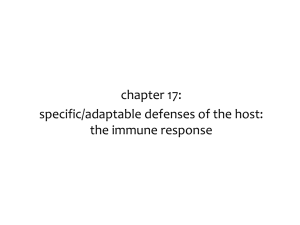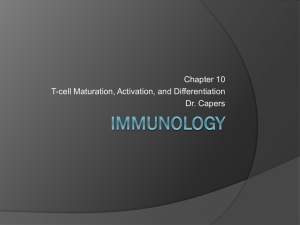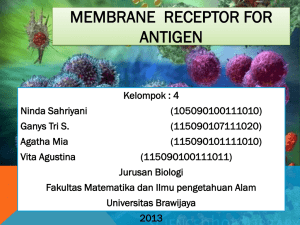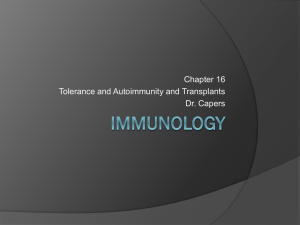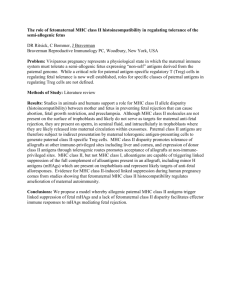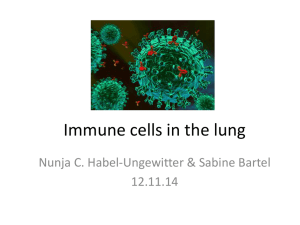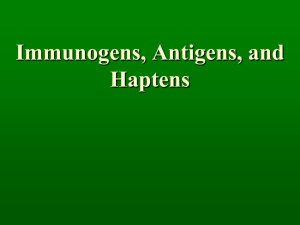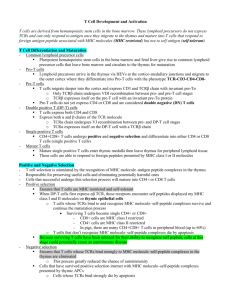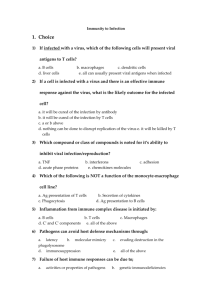UNIVERSITY OF OSLO Faculty of Mathematics and Natural Sciences
advertisement
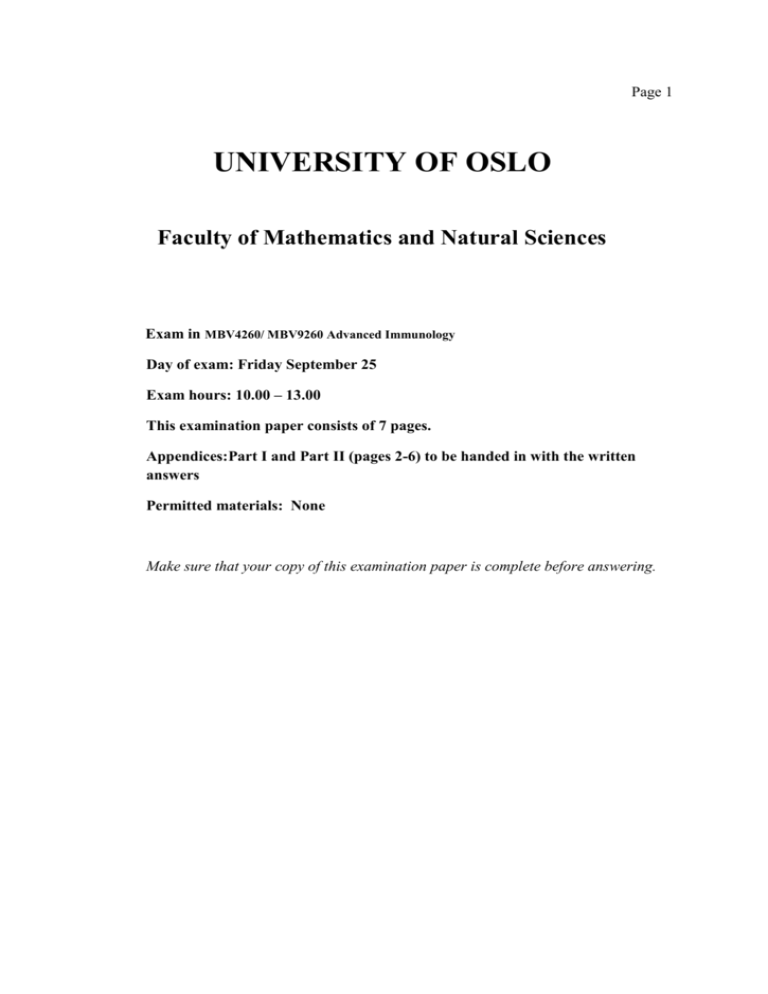
Page 1 UNIVERSITY OF OSLO Faculty of Mathematics and Natural Sciences Exam in MBV4260/ MBV9260 Advanced Immunology Day of exam: Friday September 25 Exam hours: 10.00 – 13.00 This examination paper consists of 7 pages. Appendices:Part I and Part II (pages 2-6) to be handed in with the written answers Permitted materials: None Make sure that your copy of this examination paper is complete before answering. MBV4260/MBV9260 Date: 25.9.2015 Candidate no.:________________________page 2 Part 1: Immunological concepts Indicate the INCORRECT statement for each question by circling the letter (only one statement is wrong for each question). This part count for 33% of total grade. 1. 2. 3. 4. 5. 6. 7. Acquired immune response: a. Is the response of antigen-specific lymphocytes to antigen, including the development of immunological memory. b. Is conserved in all jawed vertebrates. c. Is independent of innate immune cells. d. Is mediated by clonal selection of antigen-specific lymphocytes. e. Is necessary for vaccines to be effective. Adjuvant: a. Can be of different molecular origin such as protein, lipid or carbohydrate. b. Enhances the immune response to an antigen with which it is mixed. c. Is used in vaccines. d. Binds with low affinity but high avidity to TCR or BCR. e. Is also used in some vaccination strategies for immune deviation. Afferent lymphatic vessels: a. Are vessels of the lymphatic system that drain extracellular fluid from the tissues. b. Are found in all peripheral lymphoid organs. c. Carries antigen to lymph nodes or other peripheral lymphoid organs. d. Carries macrophages and dendritic cells from sites of infection to lymph nodes or other peripheral lymphoid organs. e. Are made up of endothelial cells. Affinity maturation: a. Is the increase in affinity for their specific antigen of the antibodies produced as an adaptive immune response progresses. b. Is particularly prominent in secondary and subsequent immunizations. c. Occurs in germinal centers. d. Depends on somatic hypermutation (SHM). e. Does not involve clonal selection. Antigen-presenting cells (APCs): a. Are highly specialized cells that can process antigens and display their peptide fragments on the cell surface together with co-stimulatory molecules required for activating naïve T cells. b. Antigen-presenting cells for naïve T cells are dendritic cells, macrophages, and B cells. c. Express MHC class II, but not MHC class I molecules. d. Only professional APCs can activate naïve T cells. e. Some APCs are located in tissues and migrate to lymph nodes upon antigen capture. Autoimmune disease: a. Disease in which the pathology is caused by adaptive immune responses to self antigens. b. Has increased in prevalence since world war II. c. Is caused by environmental factors without contribution from a genetic component. d. Typically involves CD4+ T cells. e. Autoantibodies are often associated with autoimmunity. Bone marrow: a. Is the tissue where all the cellular elements of the blood— red blood cells, white blood cells, and platelets— are initially generated from hematopoietic stem cells. b. Is the site of further B-cell development in mammals. c. Is the source of stem cells that give rise to T cells on migration to the thymus. d. Graft versus host disease (GVHD) denotes a disease where immune cells from a bone marrow transplant attacks the immune system of the recipient. e. Bone marrow transplantation can restore all the cells required for adaptive immune responses. MBV4260/MBV9260 8. 9. 10. 11. 12. 13. 14. 15. CD8: a. Date: 25.9.2015 Candidate no.:________________________page 3 Is the co-receptor for T-cell receptors that recognize peptide antigens bound to MHC class I molecules. b. CD8+ T cells are also referred to as cytotoxic T cells. c. Is only expressed on T cells. d. CD8+ T cells are important in anti-viral defense. e. Binds to the lateral face of the MHC molecule. Clonal selection theory: a. States that adaptive immune responses derive from individual antigen-specific lymphocytes that are self-tolerant. b. Is an explanation of the mechanism for the generation of diversity of antibody specificity c. Is an explanation for why only few individuals become allergic. d. States that specific lymphocytes proliferate in response to antigen and differentiate into antigen-specific effector cells that eliminate the eliciting pathogen. e. The theory was formulated by Macfarlane Burnet and in earlier forms by Niels Jerne and David Talmage. AIRE: a. Is a gene encoding a protein (autoimmune regulator) that is involved in the expression of numerous genes in the thymus. b. Enables developing T cells to be exposed to self proteins characteristic of non-thymic tissues. c. Deficiency of AIRE can effectively be treated with bone marrow transplantation. d. Thymic expression of AIRE is required for complete self-tolerance to develop. e. Deficiency of AIRE leads to an autoimmune disease, autoimmune polyendocrinopathycandidiasis-ectodermal dystrophy (APECED) Double-positive thymocytes: a. Are immature T cells in the thymus characterized by expression of both the CD4 and the CD8 co-receptor proteins. b. Represent the majority (about 80%) of all thymocytes. c. Lose expression of CD4 or CD8 before they egress from (leave) the thymus. d. Have completed positive and negative selection in the thymus. e. Have potential to bind both MHC class I and MHC class II molecules. Effector T cells: a. Are T cells that perform the functions of an immune response. b. CD4+ helper T cells (Th cells) are characterized by the cytokines they produce. c. CD8+ cytotoxic T cells directly kill bacteria. d. There are several different subsets of effector T cells, each with a specific role in an immune response. e. Require signal I and signal II to develop from naïve T cells. Germinal centers: a. Are sites of intense B-cell proliferation and differentiation. b. Develop in lymphoid follicles during an adaptive immune response. c. Peyer’s patches contain 5 or more germinal centers. d. Are the only sites where somatic hypermutation of antibody genes occur. e. Are the only sites where somatic class switching occur. Immunological ignorance: a. Is a form of self tolerance in which reactive lymphocytes and their target antigen are both detectable within an individual. b. Is always established in the thymus. c. Could explain why some tumors escape immunosurveillance. d. Reduces the chance of an autoimmune attack. e. Applies to both B cells and T cells. Central tolerance: MBV4260/MBV9260 a. 16. 17. 18. 19. 20. 21. Date: 25.9.2015 Candidate no.:________________________page 4 Is the immunological tolerance to self antigens established during lymphocyte development in central lymphoid organs. b. Occurs in thymus for T cells. c. Occurs in bone marrow for B cells. d. Central T cell tolerance refers specifically to the process of negative selection of autoreactive T cells. e. Active tolerance is mediated by regulatory, FoxP3+ CD4+ T cells that are specified in the thymus. Negative selection: a. Is the process for deletion of self-reactive thymocytes from the repertoire during T-cell development in the thymus. b. Is the process for deletion of autoreactive B cells during development in the bone marrow. c. Is important for establishment of central tolerance. d. Negative selection of T cells occurs only during the double positive stage of thymocyte differentiation. e. Is more complete for T cells than for B cells because autoreactive B cells are rather unlikely to cause disease without help from cognate (autoreactive) T cells. Peripheral lymphoid organs/peripheral lymphoid tissues: a. Denotes the lymph nodes, spleen, and mucosae-associated lymphoid tissues. b. Are lymphoid organs in which immune responses are induced. c. Are lymphoid organs in which lymphocytes develop. d. Are also called secondary lymphoid organs and tissues. e. All peripheral lymphoid organs have efferent lymphatics while some also have afferent lymphatics. Positive selection: a. Is a process occurring in the thymus in which only those developing T cells whose receptors can recognize antigens presented by self MHC molecules can mature. b. TCR transgenic mice generate equal numbers of CD4+ and CD8+ T cells by positive selection. c. Occurs during the double positive stage of thymocyte differentiation. d. Coordinates CD4 or CD8 expression with TCR specificity for MHC class II- or MHC class Ipresented peptides, respectively. e. Ensures that all mature T cells can interact with MHC. Allogeneic: a. Describes two individuals that differ at genes in the MHC locus. b. Allogeneic response of bone marrow grafts given to treat leukemia is beneficial because donor T cells can kill the recipient’s tumor cells (graft versus disease; GVD). c. Identical (monozygotic) twins are allogeneic. d. Denotes an organ transplant between non related individuals (allotransplant). e. Is due to self antigen displayed on non-self MHC. Autophagy: a. Is the digestion and breakdown by a cell of its own organelles and proteins in lysosomes. b. Genome-wide association studies (GWAS) have identified so-called autophagy genes to be involved in autoimmune disorders. c. Is a prerequisite for cross-presentation. d. Is an immune effector mechanism that may mediate pathogen clearance. e. Is one route by which cytosolic proteins can be processed for presentation on MHC class II molecules. Cross-presentation: a. Is the process by which extracellular proteins taken up by dendritic cells can give rise to peptides presented by MHC class I molecules. b. Does not occur in cod, because cod lacks CD4 molecules. c. Allows for antigen-presenting cells (APCs) to present virus antigens without being infected by the virus. MBV4260/MBV9260 d. e. 22. 23. 24. 25. 26. Date: 25.9.2015 Candidate no.:________________________page 5 FcRn promotes cross-presentation of IgG immune complexes. Enables antigens from extracellular sources to be presented by MHC class I molecules and activate CD8 T cells. Haplotype: a. Is a linked set of genes on a chromosome that are typically inherited without undergoing recombination. b. The term is used mainly in connection with the linked genes of the major histocompatibility complex (MHC). c. Because HLA-DR3 is on the same haplotype as -DQ2 in the Scandinavian population -DR3 is protective for celiac disease. d. Can be used in anthropology to trace relationship between different human populations. e. HLA I and HLA II genes are linked on the same haplotypes. Invariant chain (Ii): a. Is a polypeptide that binds the peptide-binding cleft of a newly synthesized MHC class II protein during its assembly in the endoplasmic reticulum (ER). b. Shields the MHC I and MHC II molecules from binding endogenous peptides in ER. c. Contains a signal for endosomal targeting in its cytoplasmic domain. d. In the MHC II compartment Ii is cleaved to CLIP, which sits in the groove of MHC II. e. Exchange of CLIP for foreign peptide is catalyzed by HLA-DM (in humans). MHC restriction: a. Is the fact that a peptide antigen can only be recognized by a given T cell if it is bound to a particular self MHC molecule. b. Ensures that the diversity of MHC-peptide complexes does not exceed the diversity of T cell receptors. c. MHC restriction is a consequence of events that occur during T-cell development. d. Most patients with celiac disease have gluten-reactive HLA-DQ2-restricted T cells. e. CD8+ T cells are MHC class I restricted. Hematopoiesis: a. Is the generation of blood cells. b. Occurs in the bone marrow in humans. c. Lymphoid hematopoiesis (lymphopoiesis) denotes the generation of B and T cells only. d. Leukocytes are generated from common lymphoid progenitor (CLP) or common myeloid progenitor (CMP). e. Hematopoetic stem cells are self-renewing and can give rise to all blood cells. Allergic reaction: a. Is a specific response to an innocuous environmental antigen b. Is caused by preexisting antibody or primed T cells. c. Geographic prevalence of allergy correlates with geographic distribution of helminth-borne disease, because both are driven by Th2 T cells. d. Has a genetic component. e. The most common mechanism of allergy is the binding of allergen to IgE bound to mast cells, which causes the release of histamine and other biologically active molecules MBV4260/MBV9260 Date: 25.9.2015 Candidate no.:________________________page 6 Part 2: understanding experiments in immunology This part count for 17% of total grade. In a study by Hammerschmidt et al (J Clin Invest. 2011 Aug 1; 121(8): 3051–3061) the authors investigated whether subcutaneous immunization in conjunction with retinoic acid would modify the local immune response to promote key features of gut immunity. The following figure and explanation is from the paper: CFSE-labeled OT-I or DO11.10 cells were adoptively transferred into mice. 2 hours later, a single dose of Ova was applied orally (by gavage) or injected s.c. A group of s.c. immunized mice additionally received s.c. injections of RA. The figure shows representative flow cytometry plots obtained on day 3 for “gut-homing” molecules α4β7-integrin and CCR9 and Treg marker, Foxp3 expression on OT-I or DO11.10 T cells isolated from the indicated lymph nodes. Numbers indicate percent positive OT-I or DO11.10 cells. CFSE is a fluorescent cell-staining dye which is used to monitor lymphocyte proliferation. CFSE fluorescence is progressively halved within daughter cells following each cell division. OT-1= CD8 T cells specific for Ova DO11.10= CD4 T cells specific for Ova ingLN= skin-draining inguinal lymph node mLN= mesenteric lymph node Ova= ovalbumin s.c.= subcutaneous Treg= regulatory CD4+ T cell CFSE=carboxyfluorescein succinimidyl ester Indicate (on the left) if each of the following statements are true (T), false (F) or can not be determined from the available information combined with your knowledge of immunology (ND). ____1) Antigen-presenting cells (APCs) in the mLN can present Ova on both MHC class I and MHC class II molecules. ____2) APCs in ingLN cannot activate T cell proliferation in absence of RA treatment. ____3) FoxP3 is only induced in CD4+ T cells. ____4) Expression of gut-homing molecules on T cells from ingLN in mice injected with Ova s.c. in conjunction with RA is as strong as on T cells from mLN in mice given Ova by gavage. ____5) S.c. immunization of mice in conjunction with s.c. injections of RA does not give an intestinal IgA response, which would be required for gut immunity. ____6) S.c. immunization of mice in conjunction with s.c. injections of RA gives a mixed response of CD4+ T helper cells and CD4+ Tregs. ____7) α4β7 expression on CD8+ T cells increases with increasing number of cell divisions. ____8) RA has a profound effect on T cell proliferation. ____9) RA enhances cross presentation ____10) T cells that express α4β7 are also positive for CCR9. MBV4260/MBV9260 Date: 25.9.2015 Candidate no.:________________________page 7 Part 3: short essays This part count for 50% of total grade (25% for each essay) 1) Cholera vaccination Cholera is an infection of the small intestine by some strains of the bacterium Vibrio cholerae. The classic symptom is large amounts of watery diarrhea that lasts a few days, but symptoms may range from none, to mild, to severe. Symptoms start two hours to five days after exposure. When consumed, most bacteria do not survive the acidic conditions of the human stomach, but a few surviving bacteria exit the stomach and reach the small intestine. Here they must propel themselves through the thick mucus that lines the small intestine to reach the intestinal walls where they can attach and thrive. A number of safe and effective oral vaccines for cholera are available. Dukoral, an orally administered, inactivated whole cell vaccine, has an overall efficacy of about 52% during the first year after being given and 62% in the second year, with minimal side effects. It is available in over 60 countries. (Source https://en.wikipedia.org/wiki/Cholera) Describe how Dukoral works: Where in the body and how is the vaccine taken up? What kind of immune response(s) is (are) induced? How do lymphocytes get to the anatomical locations where they exert their work? What are the effector mechanisms induced in individuals immunized by Dukoral? 2) Antibody-based therapy for cancer Antibody-based therapy for cancer has become established over the past 15 years and is now one of the most successful and important strategies for treating patients with hematological malignancies and solid tumours. Below is part of a table from the article “Antibody therapy of cancer” by Scott et al (Nat Rev Cancer. 2012, 12(4):278-87). Antigen category Examples Examples of therapeutic mAbs of antigens raised against these targets CD20 Rituximab Tumour types expressing antigen Non-Hodgkin's lymphoma Hematopoietic differentiation antigens Glycoproteins EpCAM IGN101 and adecatumumab Epithelial tumours (breast, expressed by solid colon and lung) tumours Targets of antiVEGF Bevacizumab Tumour vasculature angiogenic mAbs Growth and ERBB2 Trastuzumab and pertuzumab Breast, colon, lung, differentiation ovarian and prostate signalling tumours TABLE 2 | Tumour-associated antigens targeted by therapeutic monoclonal antibodies in oncology A) By what mechanism(s) do these antibodies promote killing of tumor cells? A new approach to antibody treatment in cancer is checkpoint blockade. Ipilimumab (an antibody against cytotoxic T-lymphocyte–associated antigen 4 [CTLA-4]) and nivolumab (an antibody against the programmed death 1 [PD-1] receptor) are examples of mAb used in this kind of treatment? B) At which stage(s) of an anti-tumor immune response do ipilimumab and nivolumab work? C) Compare and contrast the approach of treating tumors with rituximab or trastuzumab versus treating tumors with ipilimumab and/or nivolumab? (Hints: specificity for disease verses generality of tumor-fighting principles, possible side-effects, which part(s) (if any) of the patients’ immune system needs to work together with the administered antibody).
